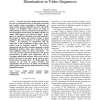Free Online Productivity Tools
i2Speak
i2Symbol
i2OCR
iTex2Img
iWeb2Print
iWeb2Shot
i2Type
iPdf2Split
iPdf2Merge
i2Bopomofo
i2Arabic
i2Style
i2Image
i2PDF
iLatex2Rtf
Sci2ools
JMM2
2007
2007
A Chaos Theoretic Analysis of Motion and Illumination in Video Sequences
— Accurate and robust image motion detection has been of substantial interest in the image processing and computer vision communities. Unfortunately, no single motion detection algorithm has been universally superior, yet biological vision systems are adept at motion detection. Recent research in neural signals have shown biological neural systems are highly responsive to signals which appear to be chaotic in nature. In this paper, we exploit these biological results and hypothesize that motion in images may produce changes in pixel amplitudes that are reminiscent of chaotic dynamical systems. In particular, we demonstrate that the trajectories of pixel amplitudes in phase space due to motion result in chaos-like behavior. We likewise demonstrate that the effects of spatio-temporally varying illumination produces phase space trajectories of the pixel amplitudes which are clearly non-chaotic. We review the research tying chaotic behavior to the fractal characteristics of phase space t...
| Added | 15 Dec 2010 |
| Updated | 15 Dec 2010 |
| Type | Journal |
| Year | 2007 |
| Where | JMM2 |
| Authors | Michael E. Farmer |
Comments (0)

